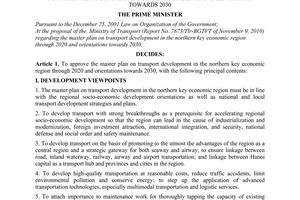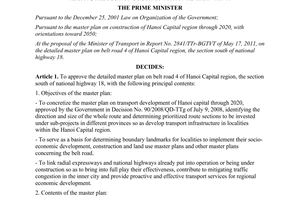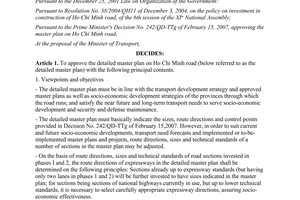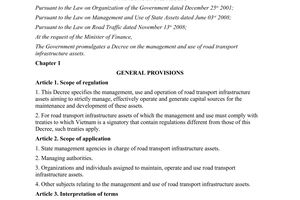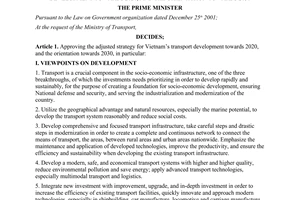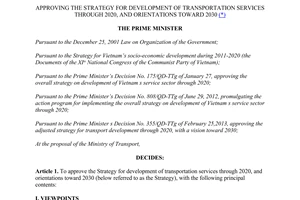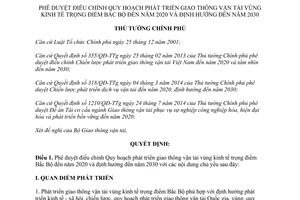Nội dung toàn văn Decision No. 2053/QD-TTg approving the adjusted master plan on transport development
|
THE PRIME
MINISTER |
THE SOCIALIST
REPUBLIC OF VIETNAM |
|
No. 2053/QD-TTg |
Hanoi, November 13, 2015 |
DECISION
APPROVING THE ADJUSTED MASTER PLAN ON TRANSPORT DEVELOPMENT IN THE NORTHERN KEY ECONOMIC REGION THROUGH 2020 AND ORIENTATIONS TOWARD 2030
Pursuant to the December 25, 2001 Law on Organization of the Government;
Pursuant to the Prime Ministers Decision No. 355/QD-TTg of February 25, 2013, approving the adjusted Strategy for development of Vietnam s transport through 2020, with a vision toward 2030;
Pursuant to the Prime Minister s Decision No. 318/QD-TTg of March 4, 2014, approving the strategy for development of transportation services through 2020, and orientations toward 2030;
Pursuant to the Prime Minister's Decision No. 1210/QD-TTg of July 24, 2014, approving the Scheme on restructuring the transport sector to serve the cause of industrialization and modernization and sustainable development through 2020;
At the proposal of the Ministry of Transport,
DECIDES:
Article 1. To approve the adjusted master plan on transport development in the northern key economic region through 2020 and orientations toward 2030, with the following principal contents:
I. DEVELOPMENT VIEWPOINTS
1. To develop transport in the northern key economic region in line with national and regional socio-economic development orientations and transport development strategies and master plans, specialized master plans and master plans of related localities; to rationally and sustainably develop the transport system to create a breakthrough prerequisite as a momentum for socio-economic development and national defense and security maintenance.
2. To develop the transport system on the basis of promoting to the utmost the advantages of the region as a central region and a strategic gateway for the country’s both seaway and airway; to promote connection among various modes of transportation, especially connection of transport infrastructure to form an uninterrupted transport network; to promote the role of Hanoi capital, Hai Phong city and Quang Ninh province as major transport hubs of the region, linking with the whole country and the world.
3. To develop high-quality transportation while still keeping reasonable fares; to step up the application of advanced technologies in transportation and management of transport activities; to speed up the development of multimodal transportation and logistics services; to use energy-efficient vehicles; to strongly develop mass transit in urban centers, especially Hanoi capital.
4. To attach importance to maintenance work for tapping to the utmost the capacity of existing transport infrastructure. To concentrate investment on synchronous important facilities that can drive economic development; to give priority to those that help tackle transport “bottlenecks”, key gateway facilities and routes with large transport demand. To attach importance to the development of local transport; to pay attention to investment in rural transport development to satisfy requirements of new countryside development.
5. To encourage social investment in developing transport infrastructure. To mobilize to the utmost resources at home and abroad and encourage all economic sectors to invest in transport development in various forms.
6. To reserve reasonable land areas for developing transport infrastructure and assure traffic safety corridors. To enhance environmental protection in transport activities; to take the initiative in effectively responding to climate change and sea level rise.
II. DEVELOPMENT OBJECTIVES
1. Development objectives through 2020
a/ Transportation:
To meet the needs for cargo and passenger transportation with good quality, safety and convenience and reasonable fare, control and reduce traffic accidents and limit environmental pollution on the basis of organizing rational transportation and strongly developing mass transit in urban centers, multimodal transportation and logistics services along transport corridors. Specific targets include:
By 2020, the entire region’s transportation volume will reach 500-550 million tons of cargo and 1,180-1,200 million passengers per year with an annual average growth rate of 10- 11 %, of which the volume of cargo to transported via seaports will be 115-160 million tons/ year. Mass transit will account for around 20-25% in Hanoi and around 5-10% in Hai Phong and other urban centers.
b/ Infrastructure facilities:
To strive to upgrade the existing system of national highways up to prescribed technical standards; to complete the construction of around 500 km of expressways by 2020. To upgrade provincial roads up to prescribed technical standards and open some new necessary routes. To further develop rural transport so that all rural roads will be hardened.
To further complete the renovation and upgrading of existing railway networks with priority given to upgrading and modernizing the North-South railway, complete the Yen Vien- Pha Lai-Ha Long-Cai Lan railway and ensure the on-schedule construction of urban railways in Hanoi capital. To gradually build railways linking seaports, inland container depots, economic zones, mining areas and major tourist centers.
To further develop Hai Phong and Quang Ninh seaports to be able to handle the cargo throughput in each period; to prioritize investment in building synchronous and modem Lach Huyen international gateway port and work out a scheme to effectively operate this port; to develop ports of appropriate size on island districts to meet socio-economic development needs and ensure national defense and security; to attach importance to investment in building navigable channels and wharves in a synchronous manner to ensure uninterrupted connection between seaports and the national transport network and regional logistics centers. To build inland container depots and other infrastructure facilities to assist the development of logistics services.
To upgrade regional inland waterways up to prescribed technical standards to ensure round-the-clock shipping operation and increase their length; to build new Phu Dong port and major passenger ports in Hanoi, Hai Phong and Quang Ninh; to shift the function of Hanoi port to mainly serve tourism in combination with the handling of clean cargo.
To upgrade and expand existing airports to meet demand in each period; to concurrently step by step build new airports as planned. To effectively exploit terminal T2 of Noi Bai International Airport. To invest in upgrading Cat Bi International Airport to support Noi Bai International Airport.
To renovate, upgrade and expand mass transit in Hanoi capital. To concurrently enhance the management and maintenance of existing urban transport facilities for efficient use; to accelerate the construction of key facilities, including urban trunk roads, radial roads, belt roads, high-volume iron-wheel transportation routes, and static traffic systems under the Hanoi capital construction master plan for solving traffic congestion and meeting people’s travel needs. To strive to reserve 16-26% of land areas for urban traffic.
2. Development orientations toward 2030
To satisfy social needs for transportation and transportation services up to international standards, with high quality, rapidity, safety, and reasonable and competitive fares.
The transport infrastructure network will be basically completed and modernized, ensuring convenient, safe and efficient transfer among various modes of transportation and connection among provinces and cities in the region and between the region and the whole country and foreign countries. The role and scale of Hai Phong international gateway seaport and Noi Bai International Airport will be equivalent to seaports and international airports in the regional countries. The urban railway network in Hanoi capital will be basically completed and effectively operated.
III. DEVELOPMENT PLANNING
1. Transportation development
To organize rational transportation on six major corridors, including:
- North-south corridor, with 4 modes of transportation: road, rail, sea and air. Long-distance cargo transportation will be mainly by road, sea and rail. Part of long-distance passenger transportation will shift to railway and airway. Short-distance and intra-provincial transportation of cargo and passengers will be mainly by road. By 2020, passenger transport by road will make up 83-85%; by rail, 5.8-6.2%, and by air, 8.8-9.2%; cargo transport by road will account for 76-79%; by rail, 6-8%; by sea, 14-16%, and by air, 0.12-0.16%.
- Hanoi-Hai Phong corridor, with 3 modes of transportation: road, rail and inland waterway. Passengers will mainly travel by road and rail while cargo will be transported by road, rail and inland waterway. By 2020, passenger transport by road will make up 96.5-97.5%; and by rail, 2.5-3.5%; cargo transport by road will account for 65-68%; by rail, 1-2%; and by inland waterway, by 31-33%.
- Hanoi-Quang Ninh corridor, with 4 modes of transportation: road, rail, inland waterway and air. Passengers will mainly travel by road, rail and air while cargo will be transported by road, rail and inland waterway. By 2020, passenger transport by road will make up 97-98%; by rail, 2-3%; and by air, around 0.03%; cargo transport by road will account for 33-35%; by rail, 4-5%; and by inland waterway and coastal route, 57-60%.
- Hanoi-Lao Cai corridor, with 3 modes of transportation: road, rail and inland waterway. Passengers will mainly travel by road and rail while cargo will be transported by road, rail and inland waterway. By 2020, passenger transport by road will represent 81-82%; and by rail, 18-19%; cargo transport by road will account for 45-49%; by rail, 11-13%; and by inland waterway, 38-42%.
- Hanoi-Lang Son corridor, with 2 modes of transportation: road and rail. By 2020, around 99% of passengers will travel by road and around 1 % by rail; cargo transport by road will account for 81-84%; and by rail, 16-19%.
- Ninh Binh-Hai Phong-Quang Ninh corridor, with 2 modes of transportation: road and inland waterway, of which road transportation will be overwhelming. By 2020, 100% of passengers will travel by road; cargo transport by road will account for around 75%; and by inland waterway and coastal routes, around 25%.
By 2030, the transportation market shares on such corridors will be further restructured in line with the orientations set out in the Prime Minister’s Decision No. 318/QD-TTg of March 4, 2014, approving the transportation service development strategy through 2020, with orientations toward2030.
To enhance connectivity and the development of multimodal transportation and logistics services:
- To increase the role of rail and inland waterway transportation on major corridors to seaports, especially between Hanoi capital and Hai Phong and Quang Ninh seaports; to combine the organization of rail transportation and inland container depot activities to raise the efficiency of, and promote, multimodal transportation and reduce logistics service costs.
- To strongly develop river and sea transport with good service quality, convenience and reasonable fare to increase its competitiveness, holding an increasing share in inland transportation, mainly on the north-south corridor. To effectively exploit the river and sea route linking Quang Ninh and Hai Phong and other provinces and cities nationwide.
- To prioritize investment in, speed up the construction of infrastructure facilities connecting modes of transportation, especially- connecting the railway to Hai Phong international gateway seaport (Dinh Vu, Lach Huyen), urban mass transit to major railway stations in Hanoi (Ngoc Hoi, Yen Vien...) and Noi Bai International Airport; to invest in large container transport logistics facilities in key areas, particularly inland container depots with railway and inland waterway connection.
- To build, upgrade and modernize railway centers and inter-provincial coach terminals in localities, especially in Hanoi capital and Hai Phong City under an approved master plan.
2. Transport infrastructure development
a/ Roads
Highways:
- Hanoi-Hai Phong expressway: around 105.5 km long from belt road III (Hanoi) to Dinh Vu dam (Hai Phong city), with 6 lanes.
- Ha Long-Hai Phong expressway: around 25.5 km long from Ha Long city (Quang Ninh province) to Bach Dang bridge (Hai Phong city), with 4 lanes.
- Noi Bai-Lao Cai expressway: the 47 km-long section within the region from the intersection between Noi Bai-Lao Cai expressway and national highway 2 (Hanoi) and Lo river bridge in Tu Yen commune, Vinh Phuc province, with 4-6 lanes.
- Hanoi-Thai Nguyen-Cho Moi-Bac Kan expressway: the 35 km-long section within the region from km 152+400 on new national highway 1A in Ninh Hiep, Gia Lam district, to Trung Gia commune, Soc Son district, Hanoi, with 4-6 lanes.
- Hanoi-Lang Son expressway: the 27.4 km-long section within the region from km 159+10 on national highway 1, Hanoi to Nhu Nguyet bridge, Bac Ninh province, with 4-6 lanes.
- Noi Bai-Ha Long expressway: around 136 km long from Bac Ninh city (Bac Ninh province) to Ha Long city (Quang Ninh province), with 4-6 lanes.
- Ha Long-Mong Cai expressway: around 128 km long from Ha Long city to Mong Cai, Quang Ninh province, with 2-4 lanes.
- Phap Van-Cau Gie expressway (belonging to the north-south expressway): around 32.3 km long from Phap Van junction (Hanoi) to km210on national highway 1A (Ha Nam province), with 6 lanes.
- Hoa Lac-Hoa Binh expressway: the 12.4 km-long section within the region from the Hoa Lac intersection at km 30+00 to km 45+00 (Hanoi), with 6 lanes. In the immediate future, to build the section up to grade-III delta road standards with 2 lanes with consideration to next- phase investment in completing the expressway.
To study the construction of Doan Hung-Hoa Lac-Pho Chau, Ninh Binh-Hai Phong-Quang Ninh and Tay Bac-Hanoi-Hai Phong expressways and upgrade and expand other expressways, depending on capital raising capacity and practical requirements.
National highways:
- National highway 1: The 83.5 km-long section within the region from km 132+245 (Bac Ninh province) to km 215+775 (Hanoi) will be maintained at grade-II road standards, with 4 lanes.
- National highway 2: The 49.8 km-long section within the region from km 0+00 (Hanoi) to km 50+650 (Vinh Phuc province) will be upgraded at least to grade-III road standards, with 4 lanes.
- National highway 5, around 95.2 km long from Nhu Quynh (Hung Yen province) at km 11+135 to Dinh Vu (Hai Phong city) at km 106+300, will be maintained at grade-II road standards, with 4 lanes.
- National highway 6: The 21.6 km-long section within the region from km 0+00 to km 32+500 (Hanoi) will be upgraded at least to grade-ill road standards, with 2 lanes.
- National highway 32: The 51.7 km-long section within the region from km 0+00 to km 63+00 (Hanoi) will be upgraded at least to grade-III road standards, with 2 lanes.
- National highway 10: The 58.4 km-long section within the region from km 0+00 (Quang Ninh province) to km 58+138 (Hai Phong city) will be upgraded to grade-II or -III road standards, with 4 lanes.
- National highway 18 is 303 km long from the intersection at national highway 1A in Dai Phuc region (Bac Ninh province) to Bac Luan bridge (Quang Ninh province). The 57 km-long Uong Bi-Bac Ninh section will be expanded to reach grade-III road standards, with 4 lanes. The Mong Duong-Mong Cai section, 124 km long, will be upgraded to grade-III road standards, with 2 lanes.
- National highway 18B, 17 km long from Hai Ha to Bac Phong Sinh border gate, Quang Ninh province, will be maintained at grade-HI road standards, with 2 lanes.
- National highway 17: The 35 km-long section within the region from Gia Lam (Hanoi) at km 0+00 to km 40+00 (Bac Ninh province) will be upgraded at least to grade-III road standards, with 2 lanes.
- National highway 18C, around 50 km long from Tien Yen bridge to the Vietnam- China border (Quang Ninh province), will be upgraded at least to grade-III road standards, with 2 lanes.
- National highway 38: The 56.5 km-long section within the region from km 0+00 (Bac Ninh province) to km 69+672 (Hung Yen province) will be upgraded at least to grade-111 road standards, with 2 lanes.
- National highway 38B: The 38.2 km-long section within the region from km 0+00 (Hai Duong province) to km 45+075 (Hung Yen province) will be expanded and upgraded at least to grade-III road standards, with 2 lanes.
- National highway 39: The 43.1 km-long section in the region from km 0+00 to km 43+130 in Hung Yen province will be upgraded at least to grade-III road standards, with 2 lanes.
- National highway 21: The 46 km-long section within the region from Son Tay town at km 0+00 to km 59+200 in Hanoi will be upgraded at least to grade-III or -IV road standards, with 2 lanes.
- National highway 2IB: The 41.6 km-long section within the region from Phu Lam at km 0+00 to km 41+500 in Hanoi will be upgraded at least to grade-III road standards, with 2 lanes.
- National highway 2B is around 25 km long from Doc Lap to Tam Dao in Vinh Phuc province. The inner city sections will be upgraded to urban road standards. The remaining section will reach grade-IV road standards, with 2 lanes.
- National highway 2C: The 46.2 km-long section within the region from km 1+00 to km 49+750 in Vinh Phuc province will be upgraded at least to grade-ill road standards, with 2 lanes.
- National highway 4B: The 27 km-long section within the region from km 80+00 to km 107+00 in Quang Ninh province will reach grade-III road standards, with 2 lanes.
- The 32 km-long section linking national highway 4B to Van Don economic zone in Quang Ninh province, from Tien Yen to the west of Cai Bau island (the major island of Van Don economic zone) to the current Van Don bridge, will at least reach grade-111 road standards, with 2-4 lanes.
- National highway 279: The 42.6 km-long section within the region from km 0+00 to km 42+600 in Quang Ninh province will be upgraded at least to grade-IV road standards, with 2 lanes.
- National highway 37: The 94.5 km-long section within the region from km 10+00 (Hai Phong city) to km 95+180 (Hai Duong province) will be upgraded to grade-III road standards, with 2 lanes.
- Ho Chi Minh Road: The 29 km-long section within the region from km 409+00 to km 438+00 (Hanoi) will comply with the Prime Minister’s Decision No. 194/QD-TTg of February 15,2012, on detailed master plan of Ho Chi Minh Road.
- Coastal road: The 307.5 km-long section within the region from Nui Do and Mui Ngoc ports in Binh Ngoc commune, Mong Cai city (Quang Ninh province) to Thanh Lan commune (Hai Phong city) will reach grade-III road standards, with 2 lanes.
Urban belt roads:
- Hanoi city belt road 3: Around 55 km long from Noi Bai-Mai Dich-Thanh Xuan-Phap Van-Thanh Tri bridge-Sai Dong-Ninh Hiep-Viet Hung-Dong Anh-Tien Duong-Nam Hong being urban road associated with expressway sections in the middle, with 4-6 lanes.
- Belt road 4 (regional belt road) will comply with the Prime Minister’s Decision No. 1287/QD-TTg of July 29, 2011, approving the detailed master plan on belt road 4 - Hanoi capital region, the section to the south of national highway 18.
- Belt road 5 (regional belt road) will comply with the Prime Minister’s Decision No. 561/QD-TTg of April 18, 2014, approving the detailed master plan on belt road 5 - Hanoi capital region.
To build and upgrade a number of priority routes, including road linking Hanoi-Hai Phong expressway and Cau Gie-Ninh Binh expressway; My Dinh-Ba Sao-Bai Dinh road. On all national highways, to step by step expand the sections running through urban and densely populated areas under the approved the master plan. To build bypasses in urban centers as necessary.
b/ Railways
Existing railways:
- To upgrade and gradually modernize the north-south railway, the 33 km-long section within the region, so that passenger trains can run at an average speed of 80-90 km per hour, and cargo trains, 50-60 km per hour.
- To renovate and upgrade railways up to national railway standards such as Hanoi-Lao Cai railway, the 42.5 km-long section within the region; the 96 km-long Hanoi-Hai Phong railway; the 54.6 km-long Dong Anh-Quan Trieu railway, the 18.5 km-long section within the region; the 156 km-long Hanoi-Dong Dang railway, the 22.5 km- long section within the region.
- To renovate and upgrade railway stations with large transportation demand to raise service quality and increase the railway transportation share, with priority given to the North-South and Hanoi-Lao Cai railways.
New railways:
- To complete and put into operation the 129 km-long Yen Vien-Pha Lai-Ha Long-Cai Lan railway.
- To study the construction of the north-south double-track express railway of 1,435 mm and prepare necessary conditions for construction of the Hanoi-Vinh section first.
- To study and build the railway in the eastern belt (the 80 km-long Yen Vien-Lac Dao-Ngoc Hoi railway) in Hanoi; the 32.65 km-long railway to Hai Phong and Lach Huyen seaports.
- To study and build Lao Cao-Hanoi-Hai Phong and Hanoi-Dong Dang railways.
To study the construction of railways in the post-2020 period: the 120 km-long Nam Dinh-Thai Binh-Hai Phong-Quang Ninh railway and the 150 km-long Ha Long-Mui Chua- Mong Cai railway.
Hanoi’s urban railways: To complete and put into operation a number of urban railways in the capital city (Cat Linh-Ha Dong; Nhon-Hanoi railway station); to concurrently invest in other urban railways under the approved master plan.
c/ Seaways
Seaports:
- Hai Phong port will be a national general port and international gate (class 1 A) with the following functional wharf zones:
+ Lach Huyen wharf zone, a major wharf zone of Hai Phong port, will mainly receive mixed cargo and containerized imports and exports on offshore routes for ships of 100,000 DWT and container ships of 8,000 TEUs; and will be capable of receiving international transshipment cargo. Infrastructure and loading, management and operation technologies will be synchronously modernized up to international standards. To build a logistics center in the industrial-service zone behind the harbor. In the immediate future, Lach Huyen wharf will be the focus of investment to build piers and technical infrastructure linking the national port network. To build the zone to reach a capacity of 35-41 million tons/year by 2020.
+ Dinh Vu wharf zone, a general wharf zone, with a special-use wharf, will mainly receive container cargo on onshore routes for ships of up to 20,000 DWT and larger ships with reduced deadweight tonnage to suit navigational conditions. To build the zone with a capacity of 18-20 million tons/year by 2020.
+ Cam river wharf zone, a local general one, will accommodate ships of 5,000-10,000 DWT and larger ships with reduced deadweight tonnage to suit navigational conditions; will not be expanded and will step by step be relocated. The function of its wharves in the inner city will be changed.
+ Nam Do Son wharf will be a potential port for conditional development to serve national defense and security.
- Quang Ninh seaport will be a national general port and regional port center (class 1), including die following wharf zones:
+ Cai Lan wharf zone, a major one of the port, will mainly receive mixed and containerized cargo for ships of up to 50,000 DWT and containers of up to 4,000 TEUs. To focus on completing this wharf zone with a port logistics center and transport network in the immediate period of the master plan. Satellite special-use wharves include B12 petrol and oil wharf (which will not be expanded, and will be relocated and its function will be changed before 2020). The sizes of special-use wharves of cement plants and Ha Long thermopower plant will be kept unchanged but in-depth investment will be made to raise their capacity and minimize their adverse impacts on the environment. In the long term, not to develop this kind of wharf in Luc estuary and Ha Long bay.
+ To build major passenger wharves for Quang Ninh and Hai Phong to receive international cruisers up to 100,000 GT and larger ships in Hon Gai area.
+ Cam Pha wharf zone will be a special-use wharf with a general container wharf to accommodate ships of 50,000-70,000 DWT at its piers and ships of 100,000 DWT in the transshipment area. To make in-depth investment in special-use south Trang bridge wharf and Cam Pha cement plant wharf as satellite ones (without expanding these wharves). To build a new oil product special-use wharf for ships of 20,000 DWT in Mong Duong; to build the zone with a capacity of25-27 million tons/year by 2020.
+ Hai Ha wharf zone will be a special-use port with a general wharf to directly serve Hai Ha industrial park and northeastern area.
+ Van Gia wharf zone, a local general port, will mainly serve Mong Cai border gate city. It will consist of a transshipment area for ships of up to 10,000 DWT and inland waterway wharves for smaller vessels in Dan Tien and along Ka Long river. To build the port with a capacity of 3.5-4.5 million tons/year by 2020.
+ Mui Chua, Van Hoa and Van Don wharf zones, as local wharves, will accommodate ships of 3,000-5,000 tons. Mui Chua wharf will be exclusively reserved for mining chemical industry, which will also receive mixed cargo for Cao Bang and Lang Son provinces; Van Hoa wharf will mainly serve national defense and security; Van Don wharf (northeastern of Cai Bau island) will mainly receive mixed cargo directly for the economic zone and accommodate ships of up to 10,000 DWT. To build the zones with a capacity of 2-2.5 million tons/year by 2020.
+ Yen Hung wharf zone will be a special-use one with a general container wharf for ships of 10,000-40,000 DWT or larger ones. It will mainly serve Yen Hung-Dam Nha Mac industrial park, repair and build vessels, and receive and supply oil products (serve the relocation of B12 petrol and oil wharf in Cai Lan). This auxiliary zone in the master plan of Lach Huyen wharf zone (Hai Phong city) will be specifically studied in a separate master plan.
+ Wharves on Co To and Bach Long Vi district islands will be satellite ones for exchange with the mainland and concurrently serving socio-economic development, national defense and security.
- Navigational channels:
To invest in building, renovating and upgrading channels to Hai Phong and Quang Ninh ports, focusing on the channels to Lach Huyen, Dinh Vu and Cai Lan wharf zones. To attach importance to regular and periodic dredging and maintenance of existing navigational channels and gradual renovation and upgrading with available resources to increase the capacity and use of the port as planned.
d/ Inland waterways
Inland waterway ports:
To upgrade Khuyen Luong port to reach a capacity of 1.7 million tons/year; to build Phu Dong cargo port with a capacity of 2.54 million tons/year; Chem-Thuong Cat port (Hanoi), 3.5 million tons/year.
Channel routes:
- Lach Giang-Hanoi route, around 187 km long, will be upgraded to grade-1 standards and renovated to be able to accommodate ships of 1,000 tons at Hanoi port, reaching grade-II channel standards; its frequency corresponding to the ship-operating water level will be 70%.
- Hai Phong-Hanoi route (via Duong river), around 154 km long, along Cam, Han, Kinh Thay, Thai Binh, Duong and Red rivers, will be upgraded in the whole route to grade-II standards.
- Quang Ninh-Ninh Binh route (via Dao and Luoc rivers), 264 km long from Luc estuary to Ninh Phuc port will reach grade-I standards; Quang Ninh-Ninh Binh route (via Lach Giang estuary) from Luc estuary to Ninh Phuc port will reach special grade and be around 178.5 km long.
- Hanoi-Viet Tri-Lao Cai route, around 362 km long. The Hanoi-Viet Tri section will be maintained at grade-II standards; the Viet Tri-Yen Bai section will be upgraded to grade-III channel standards; and the Yen Bai-Lao Cai section will be upgraded to grade-IV standards.
- Quang Ninh-Pha Lai route, around 128 km long, will be upgraded in the whole route to grade-II standards.
- Pha Lai-Da Phuc and Pha Lai-A Lu routes, around 123 km long, will be upgraded to grade-III standards.
- Van Gia-Ka Long route (on Ka Long river), from Van Gia port to Ka Long wharf (Mong Cai city), around 17 km long, will reach grade-III standards.
dd/ Airways
- Noi Bai international airport, the biggest international airport in the northern key economic region and the whole northern Vietnam, will be able to receive A380 aircraft and equivalent. To efficiently tap T2 terminal and to achieve the airport’s annual capacity of 25 million passenger arrivals and 0.5 million tons of cargo.
- Cat Bi international airport will be upgraded and expanded to reach grade 4E standards and to receive B747 aircraft with limited weight, B777-300, B777-200, and A321 aircraft and equivalent, with a capacity of 4-5 million passenger arrivals per year.
- Gia Lam airport will be renovated and upgraded for local flights and for receiving ATR72/F70 aircraft or equivalent, with a capacity of 167,000 passenger arrivals and 2,000 tons of cargo per year.
- Quang Ninh airport will be planned as a domestic airport with international flights meeting grade 4E standards and to receive A320, A313, A312 and B777 aircraft with a capacity of 700,000 passenger arrivals per year.
e/ Inland container depots
To build 5 inland container depots in the region and along the economic corridor for cargo handled at Hai Phong and Quang Ninh ports.
- In the coastal economic zone: This depot will cover around 60 hectares and mainly serve Thai Binh, Nam Dinh, Ha Nam, Ninh Binh and Hoa Binh provinces, and western Hanoi, capable of handling around 630,000 TEUs/year.
- Along the Hanoi-Lao Cai economic corridor: This depot will cover around 70 hectares and mainly serve Lao Cai, Yen Bai, Phu Tho, Vinh Phuc, Tuyen Quang and Ha Giang provinces, capable of handling around 720,000 TEUs/year.
- Along the Hanoi-Lang Son economic corridor: This depot will cover around 50 hectares and mainly serve Lang Son, Cao Bang, Bac Giang and Bac Ninh provinces, capable of handling around 550,000 TEUs/year.
- In the northwestern Hanoi economic zone: This depot will cover around 40 hectares and mainly serve Hanoi and Phu Tho, Hoa Binh, Son La, Dien Bien and Lai Chau provinces,capable of handling around 380,000 TEUs/year.
- In the southeastern Hanoi economic zone: This depot will cover around 100 hectares and mainly serve Hanoi and Bac Ninh, Hai Duong, Hung Yen, Thai Nguyen and Bac Kan provinces, capable of handling around 1.3 million TEUs/year.
To promptly take necessary steps to invest in the development of the depot system under the Prime Minister’s approved master plan.
3. Works prioritized for investment
To prioritize investment in works that can enhance the region’s connection and connection of various modes of transportation and solve traffic congestion, thus driving the region’s development (see details in the Appendix).
4. Estimated land area
Land area for development of the national transport infrastructure system in the northern key economic region under the master plan will be over 21,800 ha, accounting for 1.4% of the region’s area (excluding land for urban and local transport). Land area needed to supplement to projects will be around 10,900 ha, including 3,560 ha of rice-growing land.
IV. MAJOR SOLUTIONS AND POLICIES
1. Transportation development solutions and policies
- To create a fair business environment for all economic sectors and encourage them to engage in transportation business.
- To accelerate the restructuring of transportation market shares, invest in modes of large-capacity transportation such as national and urban railways and inland waterways so as to reduce pressure on road. To renew loading and unloading technologies at transport hubs, apply advanced transportation technologies, synchronously develop transportation support services and multimodal transportation, and improve logistic service quality.
- To restructure cargo vehicles and vessels toward focusing investment on container vehicles on railways and container ships on inland waterways and seaways; to increase container loading and unloading capacity at cargo gathering centers, especially key production and consumption areas. To encourage enterprises to renovate and modernize their vehicles and vessels, loading and unloading equipment and improve service quality to ensure convenience, safety and environmental protection.
- To promote the application of information technology in administration, management and operation of the transportation system; to establish traffic regulation centers in major cities especially Hanoi capital and along expressways in order to manage and control traffic; to synchronously implement measures to ensure traffic safety; to enhance the inspection of vehicle loading capacity; to enhance public information to raise awareness and the law-abiding sense and strictly handle violations of traffic law.
2. Transport infrastructure development solutions and policies
- To step up the implementation of the Government’s Decree No. 10/2013/ND-CP of January 11, 2013, on management, use and exploitation of road transport infrastructure.
- To effectively operate the existing transport infrastructure system. To effectively organize the maintenance of transport infrastructure facilities so as to ensure their quality and timely remedy breakdowns, incidents and black points that are likely to threaten traffic safety;
to enhance the management and effective use of road safety corridor land areas; to tighten the protection of traffic safety corridors and prevent encroachment so as to reduce compensation and site clearance costs when building and developing transport infrastructure facilities; to tighten maintenance management and raise the efficiency of the management and use of the road maintenance fund.
- To promote coordination with localities to speed up site clearance and construction activities; to develop site clearance policies which clearly define responsibilities of local leaders and site clearance parties; to strengthen local land fund development centers in order to create land areas and funds for building resettlement zones.
- To promote the application of science and technologies in designing, building, operating and maintaining transport infrastructure, thus contributing to speeding up the construction, improving the quality and reducing prices of facilities, protecting the environment, responding to climate change and sea level rise; to encourage the use of new technologies and materials.
- To review, develop and complete the transport sector’s technical standards and regulations and economic and technical norms in survey, design, construction, pre-acceptance test and maintenance activities. To raise road technical standards up to ASEAN’s road standards to ensure connectivity and international integration.
3. Funding solutions and policies
- To tighten the management of investment of state budget funds and funds raised from government bonds to ensure concentrated allocation of funds and improvement of investment efficiency. To increase transparency and accountability in the management and use of state budge funds and development cooperation funds in public investment. The state budget will only focus on the fields that are unlikely to retrieve capital or unable to mobilize private investment.
- To draw on internal resources while create favorable conditions for attracting investment capital from different economic sectors and in different forms to build and upgrade transport infrastructure. To promote social investment, especially public-private partnership (PPP) investment, in the development of transport infrastructure in order to create a breakthrough in mobilizing funding sources on the basis of studying and selecting models and completing the policy framework on PPP investment in the transport sector; to timely and fully provide information on the list of PPP investment projects.
- To create incentive mechanisms and policies for enterprises that invest in the construction of transport infrastructure under projects of great significance and in special areas associated with ensuring national defense and security, such as prioritizing them to provide roadside services (filling stations, roadside stations, weigh stations, advertisement, etc.).
4. Sustainable development and environmental protection solutions and policies in transportation
- To complete the standard system, regulations and guiding documents, environmental protection regulations in the transport sector. To enhance dissemination and education and enforcement of environmental protection law.
- To combine transport development and environmental protection integrated with response to climate change and sea level rise and energy conservation right in the process of formulating master plans and projects.
- To improve the quality of environmental supervision and protection management in transportation. To appraise environmental issues in the formulation of strategies, the master plan and projects. To strictly supervise projects to build transport facilities and industrial establishments in complying with regulations on environmental protection in order to minimize negative impacts on environment.
- Transport facilities and vehicles and vessels must satisfy technical and quality standards conformable with environmental protection requirements; advanced techniques and technologies shall be used in the construction of transport facilities; the quality of vehicle and vessels and fuel shall be controlled to reduce environmental pollution; the use of clean vehicles and fuel shall be encouraged.
Article 2. Organization of implementation
1. The Ministry of Transport shall assume the prime responsibility for, and coordinate with ministries and sectors and People’s Committees of provinces and centrally run cities in the region in, managing and organizing the implementation of this master plan. In the course of implementation of this master plan, the Ministry of Transport shall conduct reviews and evaluations for prompt modification to meet practical requirements.
2. Ministries, sectors and People’s Committees of provinces and centrally run cities in the region shall review and adjust relevant plans in line with this master plan, and at the same time coordinate with the Ministry of Transport and other ministries, sectors and localities in the course of implementation to ensure such plans are feasible and consistent, helping create an uninterrupted and interconnected regional transport system in order to increase the capacity of the whole transport network.
Article 3. This Decision takes effect on the date of its signing and replaces the Prime Minister’s Decision No. 05/2011/QD-TTg of January 24, 2011, approving the master plan on transport development in the northern key economic region through 2020 and orientations toward 2030.
Article 4. Ministers, heads of ministerial-level agencies, heads of government-attached agencies, and chairpersons of People’s Committees of provinces and centrally run cities shall implement this Decision.-
|
|
PRIME MINISTER |

